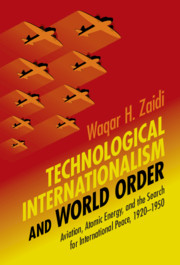 Technological Internationalism and World Order
Technological Internationalism and World Order Book contents
- Technological Internationalism and World Order
- Science in History
- Technological Internationalism and World Order
- Copyright page
- Dedication
- Contents
- Figures
- Acknowledgements
- Abbreviations
- Introduction: Machines of Peace
- 1 Invention, Interdependence, and the Lag
- 2 Controlling Scientific War
- 3 The Shape of Things to Come
- 4 Air Power for a United Nations
- 5 Wings for Peace: Planning for the Post-War Internationalization of Civil Aviation
- 6 A Battle for Atomic Internationalism: United States and the International Control of Atomic Energy
- 7 A Blessing in Disguise: Britain and the International Control of Atomic Energy
- Conclusion: Science, Technology, and Internationalism into the Cold War and Beyond
- Bibliography
- Index
5 - Wings for Peace: Planning for the Post-War Internationalization of Civil Aviation
Published online by Cambridge University Press: 25 May 2021
- Technological Internationalism and World Order
- Science in History
- Technological Internationalism and World Order
- Copyright page
- Dedication
- Contents
- Figures
- Acknowledgements
- Abbreviations
- Introduction: Machines of Peace
- 1 Invention, Interdependence, and the Lag
- 2 Controlling Scientific War
- 3 The Shape of Things to Come
- 4 Air Power for a United Nations
- 5 Wings for Peace: Planning for the Post-War Internationalization of Civil Aviation
- 6 A Battle for Atomic Internationalism: United States and the International Control of Atomic Energy
- 7 A Blessing in Disguise: Britain and the International Control of Atomic Energy
- Conclusion: Science, Technology, and Internationalism into the Cold War and Beyond
- Bibliography
- Index
Summary
Chapter Five explores planning, debates, and rhetoric about postwar civil aviation during the Second World War in Britain and the United States. As well as public rhetoric, it focuses on discussions at the 1944 Chicago conference on international aviation, and in state committees and internationalist organizations such as the Council on Foreign Relations (in the USA) and Chatham House (in Britain). The internationalism surrounding aviation was powerful enough, it argues, to manifest in a wide variety of visions for postwar aviation. This internationalism was not monolithic: the chapter emphasizes its fractured and contested nature by exploring the intermingling of political, commercial, and national interests within differing internationalist proposals. Although in both countries internationalists continued to see the aeroplane as a globalizing machine of prosperity, their proposals were also designed to safeguard national commercial interests. In Britain, a postwar aerial regime managed by a powerful international organization (the Labour Party’s policy pamphlet on the subject was titled 'Wings for Peace') was to safeguard British aviation and forestall the spread of US aviation around the world. In the United States, on the other hand, most internationalists joined state officials and the aviation industry in a consensus that global nature of aviation necessitated minimal regulation, a freedom of the air.
- Type
- Chapter
- Information
- Technological Internationalism and World OrderAviation, Atomic Energy, and the Search for International Peace, 1920–1950, pp. 147 - 180Publisher: Cambridge University PressPrint publication year: 2021
- 1
- Cited by
